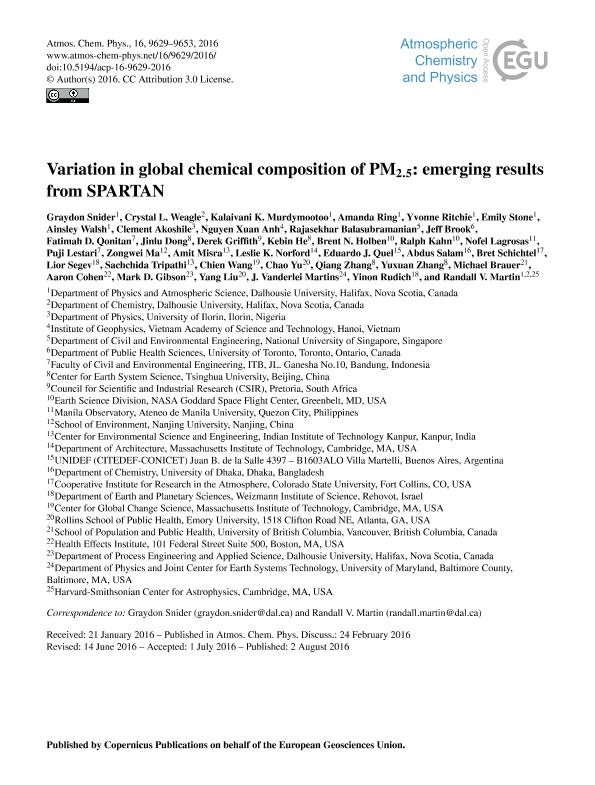Artículo
Variation in global chemical composition of PM2.5: emerging results from SPARTAN
Snider, Graydon; Weagle, Crystal L.; Murdymootoo, Kalaivani K.; Ring, Amanda; Ritchie, Yvonne; Stone, Emily; Walsh, Ainsley; Akoshile, Clement; Anh, Nguyen Xuan; Balasubramanian, Rajasekhar; Brook, Jeff; Qonitan, Fatimah D.; Dong, Jinlu; Griffith, Derek; He, Kebin; Holben, Brent N.; Kahn, Ralph; Lagrosas, Nofel; Lestari, Puji; Ma, Zongwei; Misra, Amit; Norford, Leslie K.; Quel, Eduardo Jaime ; Salam, Abdus; Schichtel, Bret; Segev, Lior; Tripathi, Sachchida; Wang, Chien; Yu, Chao; Zhang, Qiang; Zhang, Yuxuan; Brauer, Michael; Cohen, Aaron; Gibson, Mark D.; Liu, Yang; Martins, J. Vanderlei; Rudich, Yinon; Martin, Randall V.
; Salam, Abdus; Schichtel, Bret; Segev, Lior; Tripathi, Sachchida; Wang, Chien; Yu, Chao; Zhang, Qiang; Zhang, Yuxuan; Brauer, Michael; Cohen, Aaron; Gibson, Mark D.; Liu, Yang; Martins, J. Vanderlei; Rudich, Yinon; Martin, Randall V.
 ; Salam, Abdus; Schichtel, Bret; Segev, Lior; Tripathi, Sachchida; Wang, Chien; Yu, Chao; Zhang, Qiang; Zhang, Yuxuan; Brauer, Michael; Cohen, Aaron; Gibson, Mark D.; Liu, Yang; Martins, J. Vanderlei; Rudich, Yinon; Martin, Randall V.
; Salam, Abdus; Schichtel, Bret; Segev, Lior; Tripathi, Sachchida; Wang, Chien; Yu, Chao; Zhang, Qiang; Zhang, Yuxuan; Brauer, Michael; Cohen, Aaron; Gibson, Mark D.; Liu, Yang; Martins, J. Vanderlei; Rudich, Yinon; Martin, Randall V.
Fecha de publicación:
08/2016
Editorial:
Copernicus Publications
Revista:
Atmospheric Chemistry and Physics
ISSN:
1680-7316
e-ISSN:
1680-7324
Idioma:
Inglés
Tipo de recurso:
Artículo publicado
Clasificación temática:
Resumen
The Surface PARTiculate mAtter Network (SPARTAN) is a long-term project that includes characterization of chemical and physical attributes of aerosols from filter samples collected worldwide. This paper discusses the ongoing efforts of SPARTAN to define and quantify major ions and trace metals found in fine particulate matter (PM2.5). Our methods infer the spatial and temporal variability of PM2.5 in a cost-effective manner. Gravimetrically weighed filters represent multi-day averages of PM2.5, with a collocated nephelometer sampling air continuously. SPARTAN instruments are paired with AErosol RObotic NETwork (AERONET) sun photometers to better understand the relationship between ground-level PM2.5 and columnar aerosol optical depth (AOD). We have examined the chemical composition of PM2.5 at 12 globally dispersed, densely populated urban locations and a site at Mammoth Cave (US) National Park used as a background comparison. So far, each SPARTAN location has been active between the years 2013 and 2016 over periods of 2-26 months, with an average period of 12 months per site. These sites have collectively gathered over 10 years of quality aerosol data. The major PM2.5 constituents across all sites (relative contribution±SD) are ammoniated sulfate (20%±11%), crustal material (13.4%±9.9%), equivalent black carbon (11.9%±8.4%), ammonium nitrate (4.7%±3.0%), sea salt (2.3%±1.6%), trace element oxides (1.0%±1.1%), water (7.2%±3.3%) at 35% RH, and residual matter (40%±24%). Analysis of filter samples reveals that several PM2.5 chemical components varied by more than an order of magnitude between sites. Ammoniated sulfate ranges from 1.1μg m-3 (Buenos Aires, Argentina) to 17μg m-3 (Kanpur, India in the dry season). Ammonium nitrate ranged from 0.2μg m-3 (Mammoth Cave, in summer) to 6.8 μg m-3 (Kanpur, dry season). Equivalent black carbon ranged from 0.7μg m-3 (Mammoth Cave) to over 8μg m-3 (Dhaka, Bangladesh and Kanpur, India). Comparison of SPARTAN vs. coincident measurements from the Interagency Monitoring of Protected Visual Environments (IMPROVE) network at Mammoth Cave yielded a high degree of consistency for daily PM2.5 (r2 = 0.76, slope = 1.12), daily sulfate (r2 = 0.86, slope = 1.03), and mean fractions of all major PM2.5 components (within 6%). Major ions generally agree well with previous studies at the same urban locations (e.g. sulfate fractions agree within 4% for 8 out of 11 collocation comparisons). Enhanced anthropogenic dust fractions in large urban areas (e.g. Singapore, Kanpur, Hanoi, and Dhaka) are apparent from high Zn:Al ratios. The expected water contribution to aerosols is calculated via the hygroscopicity parameter κv for each filter. Mean aggregate values ranged from 0.15 (Ilorin) to 0.28 (Rehovot). The all-site parameter mean is 0.20±0.04. Chemical composition and water retention in each filter measurement allows inference of hourly PM2.5 at 35% relative humidity by merging with nephelometer measurements. These hourly PM2.5 estimates compare favourably with a beta attenuation monitor (MetOne) at the nearby US embassy in Beijing, with a coefficient of variation r2 = 0.67 (n = 3167), compared to r2 = 0.62 when κv was not considered. SPARTAN continues to provide an open-access database of PM2.5 compositional filter information and hourly mass collected from a global federation of instruments.
Palabras clave:
Spartan
Archivos asociados
Licencia
Identificadores
Colecciones
Articulos(UNIDEF)
Articulos de UNIDAD DE INVESTIGACION Y DESARROLLO ESTRATEGICOS PARA LA DEFENSA
Articulos de UNIDAD DE INVESTIGACION Y DESARROLLO ESTRATEGICOS PARA LA DEFENSA
Citación
Snider, Graydon; Weagle, Crystal L.; Murdymootoo, Kalaivani K.; Ring, Amanda; Ritchie, Yvonne; et al.; Variation in global chemical composition of PM2.5: emerging results from SPARTAN; Copernicus Publications; Atmospheric Chemistry and Physics; 16; 15; 8-2016; 9629-9653
Compartir
Altmétricas



